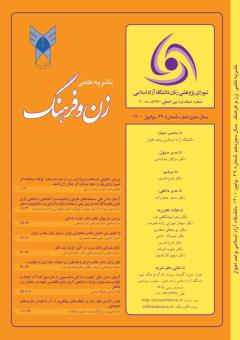رفتار مصرفی زنان عرب در آئین خرید عید فطر
محورهای موضوعی : مدیریت
رضوان بهمئی
1
![]() ,
مریم درویشی
2
*
,
مریم درویشی
2
*
![]() ,
جابر محمد موسایی
3
,
جابر محمد موسایی
3
1 - دانشگاه آزاد اسلامی واحد امیدیه، گروه مدیریت بازرگانی، امیدیه، ایران.
2 - دانشگاه آزاد اسلامی واحد امیدیه، گروه مدیریت بازرگانی، امیدیه، ایران.
3 - دانشگاه آزاد اسلامی واحد امیدیه، گروه مدیریت بازرگانی، امیدیه، ایران.
کلید واژه: پدیدارشناسی, زنان عرب, آئین خرید, رفتار مصرفی, عید فطر,
چکیده مقاله :
هدف پژوهش حاضر مطالعه پدیدارشناسانهی رفتار مصرفی زنان عرب در آئین خرید عید فطر میباشد. جامعهی پژوهش کل زنان عرب ساکن استان خوزستان بود. نمونهی پژوهش13 نفر از زنان عرب است که با این تعداد از طریق مصاحبه، نمونه به حداشباع رسید. طرح پژوهش، کیفی و با رویکرد ون منن مبتنی بر پارادایم تفسیری است. دادهها با استفاده از راهبرد پدیدارشناسی و با به کارگیری مصاحبهی نیمه ساختاریافته، بعد از اشباع نمونهها و با استخراج درون مایههای اصلی و فرعی رفتار مصرفی زنان عرب در آئین خرید عید فطر مورد تجزیهوتحلیل قرار گرفتند. نتایج چهار درون مایهی اصلی را به دست آورد که عبارتند از: معنا و مفهوم پدیدهی عید فطر و خرید عید فطر در خانواده، نقش و فرآیند خرید عید فطر در خانواده، ضرورتها و چالشهای خرید عید فطر و اثرات و پیامدهای پدیدۀ خرید عید فطر در خانواده. مهمترین یافتهای که در این مطالعه ظهور یافت؛هم پوشانی معنایی و هویتی پدیدهی عید فطر و خریدهای آئین عید فطر در میان جمعیت مورد مطالعه بود که جوهرهی دلالتی آن، رویکرد دینی به انجام فریضه و هم چنین معنای آئینی و سنت بودن آمیخته با جشن قومی است.
The research aimed to study the Arab women’s behavior of consumption on the shopping of Eid al-Fitr ritual by phenomenological methodology. The statistical population consisted of all the Arab women living in Khouzestan province. The sample included 13 Arab women, which were saturated by the interviews. The research design was qualitative with the Van Mannen method on the interpretive paradigm basis. The data were analyzed using the phenomenological strategy via semi-structured interviews. The analysis was carried out after the sample saturation and exploration of main and secondary themes. The results ended to four main themes including: “meaning and concept of the phenomenon of Eid al-Fitr and the shopping of Eid al-Fitr in the family, role, and process of shopping for Eid al-Fitr in families, necessities and challenges of shopping for Eid al-Fitr and effects and consequences of shopping for Eid al-Fitr in families. "The most important conclusion of the study was semantic and identities overlap for the Eid al-Fitr phenomenon and shopping before Eid al-Fitr among the studied population. The indicative essence of the overlap included in the religious approach, to complying the religious duty and also ritual concept and being a tradition along with the ethnic ceremony.
Ahmad, S. A., Mehmood, W., Ahmed, S. A., Mustafa, M., Khan, M. F. T., & Yasmeen, M. (2015). Impact of sales promotion on consumer buying behavior in Pakistan. International Interdisciplinary Journal of Scholarly Research, 1(3), 13-22. URL: ttps://d1wqtxts1xzle7.cloudfront.net/52279275/
Bessouh, N., Saidi, T., & Belarbi, A. (2017). Women and the purchasing decision . British Journal of Marketing Studies, 5(9), 1-12. URL: https://www.researchgate.net/publication/336568224
Bhagat, P. S., & Williams, J. D. (2008). Understanding gender differences in professional service relationships. Journal of Consumer Marketing, 25(1), 16-22. URL: https://doi.org/10.1108/07363760810845372
Chang, H. J., Yan, R.-N., & Eckman, M. (2014). Moderating effects of situational characteristics on impulse buying. International Journal of Retail & Distribution Management, 42(4), 298–314. URL: https://doi.org/10.1108/IJRDM-04-2013-0074
Danaee Fard, H., Khaef Elahi, A. & Khodashenas, L. (2012). Understanding the essence of employees' retirement experience in the public sector; Phenomenological research. Strategic Management Thought, 6(2), 153-176. [Persian] DOI: 10.30497/SMT.2013.1325
Ghavidast Kuhpayeh, M., & Faridchehr, E. (2020). Investigating the impact of culture, gender, effectiveness and perceived behavioral control on green shopping behavior with the role of moderating environmental awareness and tendency to recycle (customers of organic stores in Qazvin). Presented at the First International Conference on New Challenges and Solutions in Industrial Engineering and Management and Accounting, Sari. [Persian]. URL:https://civilica.com/doc/1045239/
Karimian Gurjini, R., & Hosseini Kia, S. M. T. (2020). Identifying consumer behavior based on customers' lifestyle and purchase decision type. 8th National Conference on Management Research and Humanities in Iran, Tehran. [Persian] URL: https://civilica.com/doc/1114338
Kolyesnikova, N., Dodd, T. H., & Wilcox, J. B. (2009). Gender as a moderator of reciprocal consumer behavior. Journal of Consumer Marketing, 26(3), 200-213. URL: https://doi.org/10.1108/07363760910954136
Kumar, P., & Varshney, S. (2012). Gendered scholarship: exploring the implications for consumer behavior research. Equality.Diversity and Inclusion: An International Journal, 31(7), 612-632. URL: https://doi.org/10.1108/02610151211263441
Pakari, A., Vazifehdoost, H., Hamdi, K. & Khalili .M. (2020). Presenting a model for measuring the impact of mental, social and behavioral stimuli on consumer purchasing decision. Consumer Behavior Studies, 7(1), 245-276. [Persian] URL: https://cbs.uok.ac.ir/article_61497.html?lang=en
Pintchman, T. (2007). Women's lives, women's rituals in the Hindu tradition. England: Published to Oxford Scholarship Online. URL: 10.1093/acprof:oso/9780195177060.001.0001
Rehman, F. U., Bin Md Yusoff, R., Bin Mohamed Zabri, S., & Binti Ismail, F. (2017). Determinants of personal factors in influencing the buying behavior of consumers in sales promotion: a case of fashion industry. Young Consumers, 18(4), 408-424. URL: https://www.emerald.com/insight/content/doi/10.1108/YC-06-2017-00705/full/html
Roy, S., Sethuraman, R., & Saran, R. (2016). The effect of demographic and personality characteristics on fashion shopping proneness: A study of the Indian market. International Journal of Retail & Distribution Management, 44(4), 426-447. URL: https://doi.org/10.1108/IJRDM-12-2014-0162
Sheng, T., & Hsiaoping Yeh, H. (2016). Gender differences in Taiwan’s hypermarkets: Investigating shopping times and product categories. Asia Pacific Journal of Marketing and Logistics, 28(4), 650-662. URL: https://doi.org/10.1108/APJML-11-2015-0171
Trentmann, T. (2009). Crossing divides: Consumption and globalization in history. Journal of Consumer Culture, 9(2), 187-223. URL: 10.1177/1469540509104374
Van Mannen, M. (2016). Researching lived experience, human science for an action sensitive Pedagogy. 2st ed. New York: Routledge. URL: https://doi.org/10.4324/9781315421056
Vaseei, A. R., & Skandari, Z. (2013). The role of women in extension of Muharram rituals at Naseeruddin shah's period. Social History Studies, 3(1), 115-132. [Persian] URL: https://socialhistory.ihcs.ac.ir/article_713.html?lang=fa
_||_
